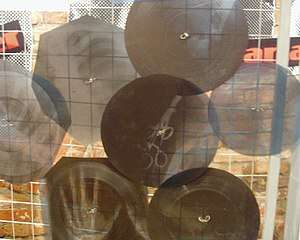Ribs (recordings)
Ribs (рёбра, translit. ryobra), also known as music on ribs (Музыка на рёбрах), jazz on bones (Джаз на костях), bones or bone music (roentgenizdat) are improvised gramophone recordings made from X-ray films. Mostly made through the 1950s and 1960s,[1][2] ribs were a black market method of smuggling in and distributing music by foreign and emigre musicians that was banned from broadcast in the Soviet Union, such as Pjotr Leschenko or Alexander Vertinsky, or Western artists such as Elvis, the Beatles, the Rolling Stones, the Beach Boys, Ella Fitzgerald and Chubby Checker.[3][4]

Production
Real medical X-rays, purchased or picked out of the trash from hospitals and clinics, were used to create the recordings. The X-rays were cut into 7-inch discs[5] and the center hole was made by burning it with a cigarette.[6] According to Russian musicologist Artemy Troitsky, "grooves were cut [at 78rpm][7] with the help of special machines (made, they say, from old phonographs by skilled conspiratorial hands)"; he added that the "quality was awful, but the price was low, a ruble or a ruble and a half."[8] The disks could really only be played five to ten times.[9]
Legality
The clandestine approach to circulating banned popular foreign music eventually led to a law being passed in 1958 that forbade the home-production of recordings of "a criminally hooligan trend".[10] The "hooligan trend" is referring to the stilyagi (from the word stil' meaning style in Russian), a subculture within the Soviet youth who were known to embrace Western styles of dress and dance.[11]
The X-Ray Audio Project
After coming across an X-ray record in St Petersburg where he had been performing in 2013, the English musician Stephen Coates of the band The Real Tuesday Weld launched The X-Ray Audio Project, an initiative to provide a resource of information about Roentgenizdat recordings with visual images, audio recordings and interviews.[12] After several years of research and interviewing bone bootleggers, his book "X-Ray Audio" The Strange Story of Soviet Music on the Bone, the first history of the culture of forbidden music and Roentgenizdat records was published by Strange Attractor in November 2015.[13]
In June 2015 Coates gave a TED talk[14] on the subject at TEDX Kraków. He and sound artist and researcher Aleksander Kolkowski went on tour, telling the story of the Soviet X-Ray bootleggers and cut new X-ray records from live musical performances as a demonstration of the process. The touring exhibition Coates created with photographer Paul Heartfield has been the subject of much media attention including pieces in The Guardian and on the BBC Today program. The pair released a long form documentary Roentgenizdat featuring interviews with original Soviet era bootleggers and archive footage in September 2016.
In 2019 Coates wrote and presented "Bone Music", a documentary based around interviews carried out in Russia for an edition of BBC Radio 3's Between The Ears series. The programme told the story of underground culture of forbidden music in cold war era Soviet Union and featured the Russian band Mumiy Troll recording a Vadim Kozin song cut straight to x-ray.[15]
See also
References
- Raleigh, Donald j. Russia's Sputnik Generation: Soviet Baby Boomers Talk about Their Lives. N.p.: Indiana University Press, 2006. Web. 13 Feb. 2016.
- Minor, William. Unzipped Souls: A Jazz Journey Through the Soviet Union. N.p.: Temple University Press, 1995. Web. 13 Feb. 2016.
- Starr, S. Frederick. "The Rock Inundation". The Wilson Quarterly (1976-) 7.4 (1983): 58–67. Web. 10. Feb. 2016
- West, Richard (Jun 25, 1965). "REDS LIKE ROCK AND ROLL---BUT NEED INTERPRETATION". Los Angeles Times. p. 1 – via ProQuest.
- Ganley, Gladys D. Unglued Empire: The Soviet Experience with Communications Technologies. N.p.: Greenwood Publishing Group, 1996. Web. 13 Feb. 2016
- "Bone Collectors." New Scientist 228.3051 (2015): 24-25. Academic Search Complete. Web. 13 Feb. 2016.
- Ganley, Gladys D. Unglued Empire: The Soviet Experience with Communications Technologies. N.p.: Greenwood Publishing Group, 1996. Web. 13 Feb. 2016
- Easton, Paul (1989). "The Rock Music Community". In Riordan, James (ed.). Soviet youth culture. 2. Basingstoke: Macmillan. p. 47. ISBN 0-333-46231-9. OCLC 246807650Available at University of Indiana
- Logan, Wendell, Satrina Yrina, and Victor Lebedev. "The Development of Jazz in the Former Soviet Union: An Interview with Victor Lebedev". Black Music Research Journal 12.2 (1992): 227–232. Web. 11. Feb. 2016.
- Ganley, Gladys D. Unglued Empire: The Soviet Experience with Communications Technologies. N.p.: Greenwood Publishing Group, 1996. Web. 13 Feb. 2016
- Edele, Mark. "Strange Young Men in Stalin's Moscow: The Birth and Life of the Stiliagi, 1945–1953". Jahrbücher für Geschichte Osteuropas 50.1 (2002): 37–61. Web. 11. Feb. 2016.
- Bone music: the Soviet bootleg records pressed on x-rays. Peter Paphides, The Guardian, 29 January 2015. Retrieved 24 December 2015.
- Coates, Stephen, X-Ray Audio: The Strange Story of Soviet Music on the Bone Strange Attractor 2015
- https://www.youtube.com/watch?v=49aWAHqi200
- Bone Music BBC documentary.
Further reading
- Coates, Stephen (Ed.) (2015). The strange story of Soviet music on the bone. London: Strange Attractor Press, ISBN 978-1-907222-38-2
- Yurchak, Alexei (1999). "Gagarin and the Rave Kids". In Barker, Adele Marie (ed.). Consuming Russia: popular culture, sex, and society since Gorbachev. Durham, N. C.: Duke University Press. p. 82. ISBN 978-0-82-232313-6. OCLC 185952345.
- Yurchak, Alexei. Chapter 6 "Imaginary West" in his book Everything Was Forever Until It Was No More: The Last Soviet Generation. Princeton University Press. 2006.
External links
- X-Ray Audio
- The Horse Hospital
- Roman Tschiedl: Bootlegs auf Röntgenfilm: Der illegale Sound des Kalten Krieges, Radio OE1, 2. April 2016 (German/English, Interviews with Stephen Coates, Aleksander Kolkowski and Masha Dabelka on Ribs recordings)